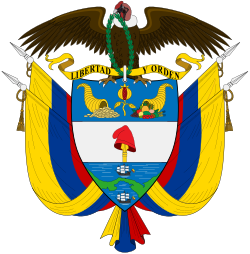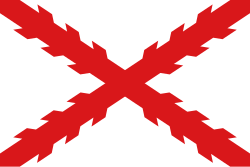This article needs additional citations for verification .(October 2015) |
New Kingdom of Granada Nuevo Reino de Granada Nuevo Reyno de Granada | |||||||||||||||||||||
|---|---|---|---|---|---|---|---|---|---|---|---|---|---|---|---|---|---|---|---|---|---|
| 1550–1821 | |||||||||||||||||||||
 The New Kingdom of Granada | |||||||||||||||||||||
| Status | |||||||||||||||||||||
| Capital | Santa Fe de Bogotá | ||||||||||||||||||||
| Official languages | Spanish | ||||||||||||||||||||
| Indigenous languages | |||||||||||||||||||||
| Religion | Catholicism | ||||||||||||||||||||
| Government |
| ||||||||||||||||||||
| King | |||||||||||||||||||||
| Viceroy | |||||||||||||||||||||
| Legislature | Council of the Indies | ||||||||||||||||||||
| Historical era | Spanish colonization of the Americas | ||||||||||||||||||||
• Established | October 12 1550 | ||||||||||||||||||||
• Viceroyalty established | May 27, 1717 | ||||||||||||||||||||
| 1540 | |||||||||||||||||||||
• Viceroyalty suppressed; kingdom autonomous again | November 5, 1723 | ||||||||||||||||||||
• Disestablished | September 27 1821 | ||||||||||||||||||||
| Population | |||||||||||||||||||||
• 1650 | 750,000 (Inc. Popayán Province) [1] | ||||||||||||||||||||
| Currency | Real | ||||||||||||||||||||
| |||||||||||||||||||||
| Today part of | Colombia Panama | ||||||||||||||||||||
| History of Colombia | ||||||||||||||||||||
|---|---|---|---|---|---|---|---|---|---|---|---|---|---|---|---|---|---|---|---|---|
 | ||||||||||||||||||||
| Timeline | ||||||||||||||||||||
| ||||||||||||||||||||
The New Kingdom of Granada (Spanish : Nuevo Reino de Granada), or Kingdom of New Granada, was the name given to a group of colonial-era Spanish ultramarine provinces in northern South America governed by the president of the Real Audiencia of Santa Fe, an area corresponding mainly to modern-day Colombia. The conquistadors originally organized it as a province with a Real Audiencia within the Viceroyalty of Peru and thus having a certain level of independence from it. The audiencia was established by the crown in 1549.[ citation needed ]
Contents
- History
- European colonization
- Regularization of the government
- Demographics
- List of governors
- Real Audiencia
- Administrative divisions
- See also
- Further reading
- References
- External links
Later, the kingdom would become the Viceroyalty of New Granada, first in 1717, and permanently in 1739. After several attempts to set up independent states in the 1810s, the kingdom and the viceroyalty ceased to exist altogether around 1819 with the establishment of the first Republic of Colombia. [2]

